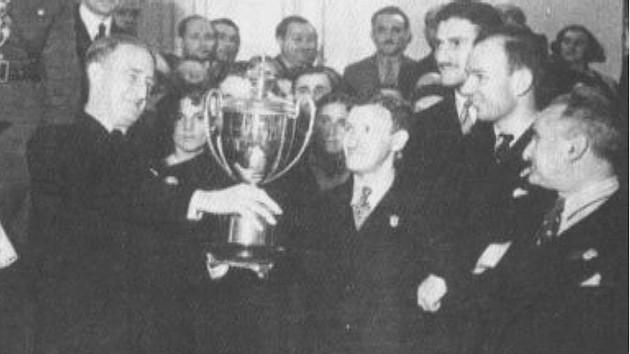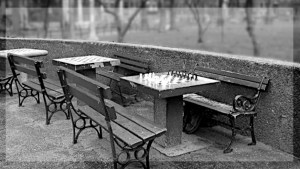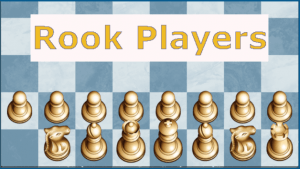
The Golden Age

In September 1945 the proud and confident USA team suffered a humiliating, crushing defeat at the hands of the Soviet team in a 10 board, 20 game match played through a novel use of radio transmission, each set of matched contestants played the other as both White and Black. The Soviet team won 14 and lost only 3. The only American with a plus score was Herman Steiner. While it was no secret that the Soviet players were strong, the extent of that strength came as a shock.
After announcing the proposed match, there was some speculation about who had the better chance of winning:

"Chess Review," May, 1945
WWII had just ended in Europe. While it had a devastating effect on Russia in terms of destruction and lives lost, it put the finishing touches on the Great Depression in America and transformed the country from a Sleeping Giant to a Superpower with a sense of international destiny. This possibly made such an uneven match loss even more confounding.
This portentious weekend in the beginning September 1945 marked the end the Golden Age of Chess in America and the start of the Soviet Hegemony.
WWII greatly curtailed international chess events and the years between 1939 and 1945 constrained the game to partial state of limbo. Germany had invaded Poland at the beginning of the 1939 Chess Olympiad in Buenos Aires. The two top teams from the previous Olympiad, the USA and Hungary had chosen not to attend at all. This inauspicious event was followed by eleven years of Olympiad silence. It wasn't until 1950 when the next Olympiad took place (rather perversely, the USA team, though undefeated, won no medal). The USSR had never participated in these events until 1952 but throughout the next half-century — 26 Olmpiads out of which the USSR/Russia took the gold in 24 contests, the silver in 1 (1978: Hungary, gold; USA, bronze) and abstained from one (1976, played in Israel) — except for Fischer's brief tenure as World Champion, there was no doubt which nation led the international chess world.
However, during the decade preceding WWII, the U.S. was a dominant player in international chess as measured through its Olympiad successes.
Back then the Olympiads were called International Team Tournaments. Starting with the first official Olympiad until WWII, the Women's World Championship had taken place concurrent with that event.

"Glascow Herald," Aug. 4, 1937
The first official chess Olympiad took place in London in1927. The United States didn't participate, but the first women's chess championship (won, of course by Menchik) did occur.
The second Olympiad, played in Hague just the following year saw the United States participating for the first time and winning the silver (behind Hungary).
In the third Olympiad, played in 1930 in Hamburg, the US team, in spite of it's line-up consisting of Frank Marshall, Isaac Kashdan, Herman Steiner, Harold Phillips and James Allen Anderson (three time St. Louis Champion), placed only sixth.
It was at the fourth Olympiad at Prague 1931, where the U.S. fielded the dream team of Al Horowitz, Frank Marshall, Isaac Kashdan, Arthur Dake and Herman Steiner, that the United States finally reached its stride and won the gold for the first time.

(L-R) Dake, Kashdan, Marshal, Horowitz, Steiner
with the Hamilton-Russell Cup
The fifth Olympiad, played at Folkestone, England in 1933 saw the same team with the one exception of Albert Simonson filling Horowitz' spot. The Untied States, as in the previous event, narrowly won the gold.

The 1933 team (minus Simonson)

"The Glasgow Herald," Jun. 22, 1933

"Spokane Daily Chronicle," Aug. 1, 1933
. . .a little perspective
The sixth Olympiad, hosted by Warsaw in 1935, was also a close tournament with the American team of Marshall, Dake and Horowitz bolsted by the inclusion of Abraham Kupchik and young Reuben Fine.

The 1935 team (minus Kupchik)


under "Warsaw Details"
"The Glasgow Herald," Sep. 7, 1935
The United States had been bringing home the gold, but in the seventh Olympiad at Stockholm in 1937 they did it in style, a full 6 points ahead of the silver team. This team consisted of "regualrs" Marshall, Horowitz, Kashdan and Fine with the additional fire-power of former child prodigy, Samuel Reshevsky. 1937 was also the first year the U.S. sent a representative to the women's championship. Adele Rivero had won the championship of the National Chess Federation whose announced purpose was to send the winner to Stockholm. Rivero was unable to go and second-place Mary Bain took her spot. Although she came in fifth, Ms. Bain expressed her surprise that all the other contestants had coaches and trainers as well as their surprise that she and Rivero had none. Vera Menchik won the event as expected.

The winners of the open tournament took possession of the Hamilton-Russell Cup (named for its donor, Frederick Gustavus Hamilton-Russell, once president of the British Chess Association). Below is the trophy in U.S. hands.

The 1937 Stockholm tournament took place the first part of August during which time all eyes were focused on the impending rematch between Alekhine and Euwe. There was minimal media coverage and many of the games have been lost. In 1985 W.H. Cozens published a book on that tournament containing about 200 of the games. He titled the book, quite appropriately, "The Lost Olympiad."
In 1946 Al Horowitz wrote a brief, clever article describing a draw he played against Gösta Danielsson. Unfortunately (or possible fortunately, as the article may indicate) this was one game that seems unrecorded anywhere and Horowitz kept the score to himself:

THE CHESS CLOCK is the instrument which governs the time comtrol of the contestants. A speck of white between the minute hand and the twelve o'clock mark is sufficient to exact a forfeit penalty of the dilatory player. Small wonder it is then that "time trouble" produces exciting and even lucicrous situations.
Witness the following incident. The place : Stockholm, Sweden ; the occasion : the International Team Tournament of 1937 ; the game : Horowitz versus Danielsson. In the early 30s, Sweden had developed three great players : Stahlberg, Stolz and Lundin. Now Danielsson had risen to fame.
Standard moves initiated the opening. The position took a turn and Horowitz assumed the lead. His forces poised for action in the general direction of the opposing King. He closed in. He let go a sockdolager, N-KN4, and it made the rafters ring. The game was over. . . . But was it? Danielsson continued. He countered "feebly" with B-QB1. What did that have to do with the case (tra-la)? A temporary expedient. But wait. It attacked the Knight, the pivotal active piece. So the Knight will move. No, it can't. A Pawn will go by the wayside.. Nor can it stay, it will be captured. Dilemma.
This was no mean problem With one fell move, the attack wrenched loose from its hinges and an important Pawn was about to fall.. Wih full realization of the import, Horowitz contemplated the future. Shall he consolidate, fight it out with a Pawn minus and hope for a blunder? Or shall he stand his ground and maintain the mock assult?
As he pondered, the clock kept ticking away. At long last, after an hour's deliberation, to be exact, Horowitz stood his ground.. But the hour registered on the clock and left Horowitz two measly minutes to complete twenty moves.. With the calm and coolness of experience, he steeled himself for the ordeal.
Again Danielsson faltered. In short order the attack regained its momentum. But diehard Danielsson wouldn't give up the ghost. He studied and studied until he had less than a minute for nearly twenty moves. He lost composure, fidgeted and quaked, shook like a leaf.
Oddly, this was the only defense ! For the demeanor was contageous. In a split second both players shook and quaked and the hysteria was reflected in the moves. The game ended a draw.
Oh tempora! Oh Horowitz!

Rather oddly, the American Chess Federation and the National Chess Federation merged into the United States of America Chess Federation (USCF), immediately following the closing of the 1939 event for which the U.S. was unable to afforded to sponsor a Olympiad team after major support was withdrawn upon learning that neither Fine nor Reshevsky would participate.

Below are the winning percentages of the individual Olympiad team members during the 1930s winning streak .
Frank Marshall everyone knows. Revered by his contemporaries, he was probaby considered THE U.S. Champion until his death. Although a world class player and a marvelous tournament player, his match play against Lasker and Capablanca was surprisingly dismal. His Olympiad results, while decent, fell short of expectations.
Samuel Reshevsky, the ultimate child prodigy, was probably the strongest U.S. player until Fischer. He was an accountant who often took a chess hiatus to pursue his career. He had decent Olympiad results over the years.

Reuben Fine, another prodigical player, was one of the leading chess players in the world from the early 1930s until after WWII. He won several international tournaments but his main success was probably scoring even with Keres at AVRO in 1938, losing only in the play-off. After WWII, Fine earned his PhD in psychology and retired from active chess. Fine's record against the very best players of his day are generally favorable. During Fine's active years, only Reshevsky of all the American players was his equal.

Isaac Kashdan was a powerhouse from Los Angeles who moved to NYC for a while. An insurance salesman, his chess involvement was curtailed by his somewhat meager living. He played in 5 Olympiads scoring a 79.9% win rate. Along with Horowitz, he founded "Chess Review," though he sold out after a short time. Immensely talented, his potenetial was only ever partially realized.

Israel Albert Horowitz worked on Wall Street before turning to chess as a full-time passion. He founded "Chess Review" and published it for over 30 years. His Olympiad results were fantastic, averaging 75.5% in his four events.

Albert Charles Simonson was a rich kid from Manhattan. Quite precocious, he was only 18 when he earned a place on the 1933 Olympiad team set to play at Folkestone. Three years later, he tied for 1st place with Kashdan for the Manhattan C.C. championship and then, a few short months later, as the youngest participant, came in second behind Reshevsky in the U.S. Championship. He remained one of the the top players throughout his abbreviated lifetime, dying at age 50.

Abraham Kupchik, like Reshevsky, was an accountant. The Russian-born master became the almost perpetual Manhattan Club champion but his claim-to-fame was tying for first with Marshall at Lake Hopatcong in 1923 ahead of such players as David Janowski, Edward Lasker, Albert Hodges and Tony Santasiere.
Kupchik was granted a patent in 1954 for his "Gridiron" rotissiere devise for a barbeque grill:

Arthur Dake, who spent most of his working life at the Oregon DMV, played in three Olympiads: with good results in Prague and Folkestone, but with excellent results in Warsaw (and as a reward, met his future wife on the way home). Most unusual -astonding really- is that he only learned chess at age 17, reached master level by age 20 (when he won the Marshall C.C. championship) and then retired from chess at age 28 (he made a come-back at Lone Pine in 1975). He became not just a master (later an honorary GM), but one of the leading masters in the United States during his short chess career.

"The Milwaukee Journal," Jan. 24, 1936
The "Golden Age" can be thought of in terms other than Olympiad successes. As mentioned, 1937 saw the first U.S. women participating the the Women's World Chess Championship. In 1938 Mona May Karff won the first tournament announced as being the U.S. Women's Championship (see HERE). The next year the USCF was created. Players such as Horowitz, Fred Reinfeld, Reuben Fine and Irving Chernev wrote exciting articles and published books still appreciated today. Many names, such as Herman Helms, Arnold Denker, Barnie Winklemsn, Arpad Elo, George Sturgis, Harold Philips, Fritz Breiger, Alexander Kevitz, Milton Hanauer, Weaver Adams, Tony Santasiere, Samuel Factor, Jack Collins and George Shainswit, are familiar to many chess-players.
Below is a group photo of the 1936 U.S. Championship players:

Some of our heroes in 1938:

As with the Wild West, the Great Depression, the Golden Ages of baseball, television or films, the Innocent 1950s or the 1960s Counter Culture, there are many iconic periods in the United States life. This self-dubbed "American Golden Age of Chess" is also iconic and maybe even nostalgic, just as it is exciting to examine. Surely America never reclaimed its brief ascendancy except possibly and vicariously through Bobby Fischer.
O Tempora! O Mores!
Oh Horowitz!







